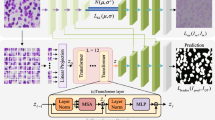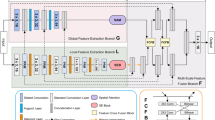Abstract
In the past years, semantic segmentation method based on deep learning, especially Unet, have achieved tremendous success in medical image processing field. However, due to the limitation of traditional convolution operations, Unet cannot realize global semantic information interaction. To address this problem, this paper proposes a deep learning model based on Unet. The proposed model takes the Residual network as the image feature extraction layer to alleviate the problem of gradient degradation and obtain more effective features. Besides, we add Squeeze-and-Excitation block to the encoder layer, which helps the whole network get the importance of each feature channel, and then improve the useful features and suppress the less useful features according to the importance, so as to improve the segmentation accuracy. According to the experiments on two medical image datasets, our method achieved better segmentation performance than other deep learning-based algorithms, which verified the effectiveness and efficiency of our method.
Access this chapter
Tax calculation will be finalised at checkout
Purchases are for personal use only
Similar content being viewed by others
References
Jiang, N., Duan, F., Chen, H., Huang, W., Liu, X.: MAFI: GNN-based multiple aggregators and feature interactions network for fraud detection over heterogeneous graph. IEEE Trans. Big Data (2021). https://doi.org/10.1109/TBDATA.2021.3132672
Jiang, N., Huang, D., Chen, J., Wen, J., Zhang, H., Chen, H.: Semi-direct monocular visual-inertial odometry using point and line features for IoV. ACM Trans. Internet Technol. 22(1), 1–23 (2022)
Jiang, N., Gao, L., Duan, F., Wen, J., Wan, T., Chen, H.: SAN: attention-based social aggregation neural networks for recommendation system. Int. J. Intell. Syst. (2021). https://doi.org/10.1002/int.22694
Tu, B., Zhao, Y., Yin, G., Jiang, N., Zhang, Y.: Research on intelligent calculation method of intelligent traffic flow index based on big data mining. Int. J. Intell. 37(2), 1186–1203 (2022). https://doi.org/10.1002/int.22665
Hua, S., Liu, Q., Yin, G., et al.: Research on 3D medical image surface reconstruction based on data mining and machine learning. Int. J. Intell. Syst. 37, 4654–4669 (2021)
Zhang, Y., Zhao, Y., Yin, G., Guan, X., Zhong, M., Li, G.: Secure data stream transmission method for cell pathological image storage system. Int. J. Intell. Syst. 37(2), 1552–1571 (2022). https://doi.org/10.1002/int.22685
Simonyan, K., Zisserman, A.: Very deep convolutional networks for large-scale image recognition. arXiv preprint arXiv:1409.1556 (2014)
Szegedy, C., Liu, W., Jia, Y., et al.: Going deeper with convolutions. In: Proceedings of the IEEE Conference on Computer Vision and Pattern Recognition, pp. 1–9 (2015)
Long, J., Shelhamer, E., Darrell, T.: Fully convolutional networks for semantic segmentation. In: Proceedings of the IEEE Conference on Computer Vision and Pattern Recognition, pp. 3431–3440 (2015)
Weng, W., Zhu, X.: Convolutional networks for biomedical image segmentation. IEEE Access (2015)
Zhou, Z., Siddiquee, M.M.R., Tajbakhsh, N., et al.: A nested U-Net architecture for medical image segmentation. arXiv, arXiv preprint arXiv:1807.10165 (2018)
Alom, M.Z., Yakopcic, C., Taha, T.M., et al.: Nuclei segmentation with recurrent Residual convolutional neural networks based U-Net (R2U-Net). In: NAECON 2018-IEEE National Aerospace and Electronics Conference, pp. 228–233 IEEE ()018
Huang, H., et al.: UNet 3+: a full-scale connected UNet for medical image segmentation (2020)
Zhang, Z., Liu, Q., Wang, Y.: Road extraction by deep Residual UNet. IEEE Geosci. Remote Sens. Lett. 15(5), 749–753 (2018)
Chen, L.C., Papandreou, G., Kokkinos, I., Murphy, K., Yuille, A.L.: DeepLab: semantic image segmentation with deep convolutional nets, atrous convolution, and fully connected CRFs. IEEE Trans. Pattern Anal. Mach. Intell. 40(4), 834–848 (2018). https://doi.org/10.1109/tpami.2017.2699184
He, K., Zhang, X., Ren, S., Sun, J.: Spatial pyramid pooling in deep convolutional networks for visual recognition. IEEE Trans. Pattern Anal. Mach. Intell. 37(9), 1904–1916 (2015). https://arxiv.org/abs/1406.4729
Hu, J., Shen, L., Sun, G.: Squeeze-and-excitation networks. In: Proceedings of IEEE Conference on Computer Vision and Pattern Recognition (CVPR), pp. 7132–7141 (2018)
Acknowledgments
This paper was supported by the National Natural Science Foundation of China Project No. 61863013.
Author information
Authors and Affiliations
Corresponding author
Editor information
Editors and Affiliations
Rights and permissions
Copyright information
© 2023 The Author(s), under exclusive license to Springer Nature Switzerland AG
About this paper
Cite this paper
Liu, S., Wu, F., Tang, J., Li, B. (2023). A Medical Image Segmentation Method Based on Residual Network and Channel Attention Mechanism. In: Xu, Y., Yan, H., Teng, H., Cai, J., Li, J. (eds) Machine Learning for Cyber Security. ML4CS 2022. Lecture Notes in Computer Science, vol 13656. Springer, Cham. https://doi.org/10.1007/978-3-031-20099-1_5
Download citation
DOI: https://doi.org/10.1007/978-3-031-20099-1_5
Published:
Publisher Name: Springer, Cham
Print ISBN: 978-3-031-20098-4
Online ISBN: 978-3-031-20099-1
eBook Packages: Computer ScienceComputer Science (R0)




